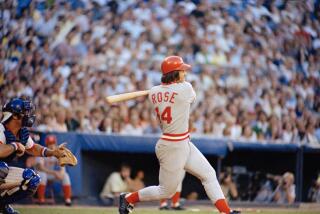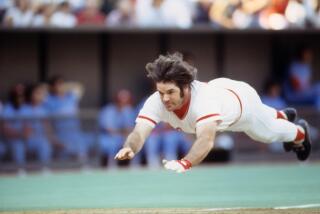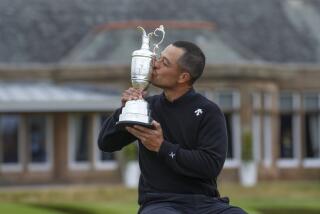Rose seeks another roar
- Share via
SOUTHPORT, England -- Against the Irish Sea and between such menacing foliage as sea buckthorn, common polypody and the always-malevolent gorse, major golf has returned to the site of one of its all-time roars.
That roar belongs in any roar pantheon alongside dins for Jack at Augusta in 1986 or Tiger at Torrey in 2008, and it lingers in aural memory even though it blared way back in 1998, so long ago that the English lad who used his wedge to cause it, Justin Rose, has lived about five lifetimes since then.
Returning as a married, ripened grown-up of 27 ranked No. 9 in the world in 2008 and No. 1 in Europe for 2007, Rose joins 155 other golfers at the 137th British Open at Royal Birkdale, where members and their guests routinely try to replicate the 59-yard approach he holed on No. 18 to send the bleachers into stunning clamor.
“Obviously ’98 was a magical week,” said Rose, who finished tied for fourth then, the best finish for an amateur since 1953 and the best finish for a 17-year-old since Young Tom Morris won the thing in 1868 without 12 TV camera crews waiting at his home upon return.
Of course, Rose then turned professional the next day as planned months earlier, missed 21 straight cuts, drove to Birkdale one fall day in 2000 but just couldn’t bring himself to get out of the car after so much struggle, thrived finally in 2002, and lost his father and mentor, Ken, a calm and friendly presence among reporter scrums back in 1998, to leukemia at 57 in September 2002.
After so much calamity both worryingly professional and deeply personal, Rose does find one thing unchanged at Birkdale: England, with a batch of chronically promising players including Rose, still craves its first winner since Nick Faldo claimed his third Claret Jug in 1992 at Muirfield, and its first major title since Faldo marched through Greg Norman’s rubble at the 1996 Masters.
In fact, the eight Opens played at Birkdale have yielded winners only American (Mark O’Meara, Tom Watson, Johnny Miller, Lee Trevino and Arnold Palmer) and Australian (Ian Baker-Finch and Peter Thomson twice).
“I think it’s a coincidence,” said Adam Scott, No. 4 in the world and Australian.
It’s an unusually open Open. Tiger Woods sits home with a mending knee. The hottest player on the U.S. PGA Tour, Kenny Perry, chose to play in Milwaukee. The defending champion from Ireland, Padraig Harrington, arrived with a screaming wrist, a stash of painkillers and some doubt he could go the full 72.
Wind, so pushy in 1998 especially on the Saturday, will have its say, according to meteorologists.
And of all the plot lines that could stomp up No. 18 on Sunday, the most storybook might be Rose, whose London flat reportedly boasts a picture of him with his father at No. 18 on July 19, 1998, just after that shot and that din.
“I don’t think I’ve ever had that -- not that same buzz, especially the way it finished,” Rose said. “There’s no bigger buzz I’ve ever experienced than that moment on the 18th green when that pitch shot went in. There’s no doubt about it. I think I’ve had as satisfying moments on the golf course, but never quite that . . . same sort of buzz.”
In a “very unique situation,” as Rose called it, the crowd constructed its pandemonium through the week behind a virtual unknown teen whose 66 on Friday bested the average score by nine shots. People around the world learned of his birth in South Africa, his family’s move to England, his residence in a village near London called Hook, with no apparent Slice nearby.
Then things fizzled and fizzled hard, but his father reportedly retained good humor through the drought, remaining supportive, and when Rose did win at 21 in the Dunhill Championships in South Africa in 2002, he got to take the trophy into his father’s hospital room. The month before his death, Ken Rose did get to sit in a portable chair in Minnesota and see his son finish tied for 23rd at the PGA Championship.
Some stout major finishes have come in recent years -- fifth at the 2003 U.S. Open, fifth at the 2007 Masters, a sterling 2007 major record of T5, T10, T12, T12 -- but he hasn’t matched the fourth place he somehow pulled off at 17, or the buzz that greeted its last shot.
Still only 27 and remembering the roar, Rose said, “I think I’d need for me to win it to go one better than ’98.”
--
(BEGIN TEXT OF INFOBOX)
Royal Birkdale
Opens: 1954, 1961, 1965, 1971, 1976, 1983, 1991, 1998, 2008.
Location: Southport, England.
Course length (2008 Open): 7,173 yards, par 71.
History: Royal Birkdale is the golfing jewel of a stretch of beautiful links land that runs almost uninterrupted for 20 miles north of Liverpool. The course was established in 1889 but was extensively redesigned in 1922 by Fred Hawtree and J. H. Taylor to create the current layout, which is characterized by its picturesque, snaking course through the sand dunes which tower over each of the fairways.
The Open was originally set to visit Royal Birkdale in 1940, but the advent of war delayed this until 1954; since then, however, the course has been (alongside Royal Lytham) the most regular venue for the Championship other than St Andrews. The 2008 Open marks the ninth visit of the event to the Merseyside links.
At Birkdale’s first Open, Peter Thomson won the first of three Opens in succession; he returned to the same course in 1965 to add his fifth and final title. Arnold Palmer’s victory in 1961 is recognized as the turning point in the fortunes of the Open, giving new life and international impact to the championship. Since 1971, American players have dominated Birkdale’s Opens, with only Australian Ian Baker-Finch in 1991 breaking the run of successes achieved by Lee Trevino (1971), Johnny Miller (1976), Tom Watson (1983) and Mark O’Meara (1998).
--
Source: www.opengolf.com
--
BRITISH OPEN
Today-Sunday at Royal Birkdale, Southport, England.
TV: TNT (delayed) 7 a.m. and 3 p.m. PDT.
More to Read
Go beyond the scoreboard
Get the latest on L.A.'s teams in the daily Sports Report newsletter.
You may occasionally receive promotional content from the Los Angeles Times.










